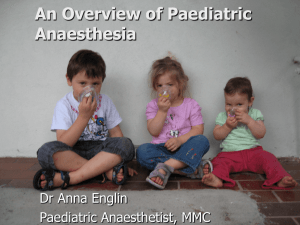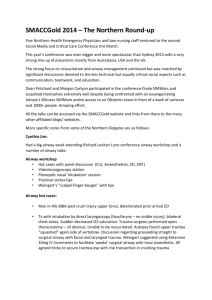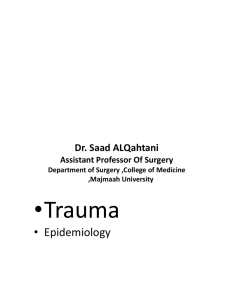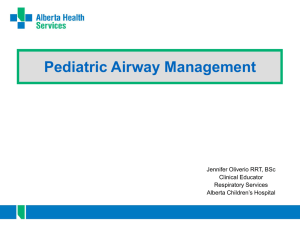Adam _Fisher_Abstract_Airways
advertisement
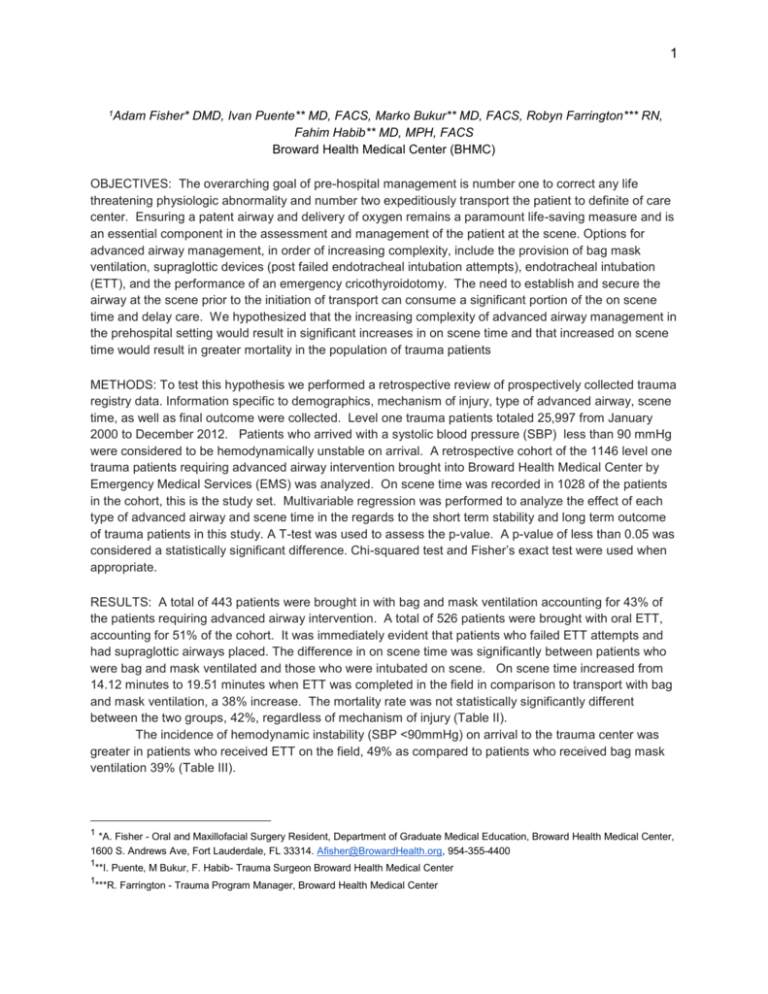
1 1Adam Fisher* DMD, Ivan Puente** MD, FACS, Marko Bukur** MD, FACS, Robyn Farrington*** RN, Fahim Habib** MD, MPH, FACS Broward Health Medical Center (BHMC) OBJECTIVES: The overarching goal of pre-hospital management is number one to correct any life threatening physiologic abnormality and number two expeditiously transport the patient to definite of care center. Ensuring a patent airway and delivery of oxygen remains a paramount life-saving measure and is an essential component in the assessment and management of the patient at the scene. Options for advanced airway management, in order of increasing complexity, include the provision of bag mask ventilation, supraglottic devices (post failed endotracheal intubation attempts), endotracheal intubation (ETT), and the performance of an emergency cricothyroidotomy. The need to establish and secure the airway at the scene prior to the initiation of transport can consume a significant portion of the on scene time and delay care. We hypothesized that the increasing complexity of advanced airway management in the prehospital setting would result in significant increases in on scene time and that increased on scene time would result in greater mortality in the population of trauma patients METHODS: To test this hypothesis we performed a retrospective review of prospectively collected trauma registry data. Information specific to demographics, mechanism of injury, type of advanced airway, scene time, as well as final outcome were collected. Level one trauma patients totaled 25,997 from January 2000 to December 2012. Patients who arrived with a systolic blood pressure (SBP) less than 90 mmHg were considered to be hemodynamically unstable on arrival. A retrospective cohort of the 1146 level one trauma patients requiring advanced airway intervention brought into Broward Health Medical Center by Emergency Medical Services (EMS) was analyzed. On scene time was recorded in 1028 of the patients in the cohort, this is the study set. Multivariable regression was performed to analyze the effect of each type of advanced airway and scene time in the regards to the short term stability and long term outcome of trauma patients in this study. A T-test was used to assess the p-value. A p-value of less than 0.05 was considered a statistically significant difference. Chi-squared test and Fisher’s exact test were used when appropriate. RESULTS: A total of 443 patients were brought in with bag and mask ventilation accounting for 43% of the patients requiring advanced airway intervention. A total of 526 patients were brought with oral ETT, accounting for 51% of the cohort. It was immediately evident that patients who failed ETT attempts and had supraglottic airways placed. The difference in on scene time was significantly between patients who were bag and mask ventilated and those who were intubated on scene. On scene time increased from 14.12 minutes to 19.51 minutes when ETT was completed in the field in comparison to transport with bag and mask ventilation, a 38% increase. The mortality rate was not statistically significantly different between the two groups, 42%, regardless of mechanism of injury (Table II). The incidence of hemodynamic instability (SBP <90mmHg) on arrival to the trauma center was greater in patients who received ETT on the field, 49% as compared to patients who received bag mask ventilation 39% (Table III). 1 *A. Fisher - Oral and Maxillofacial Surgery Resident, Department of Graduate Medical Education, Broward Health Medical Center, 1600 S. Andrews Ave, Fort Lauderdale, FL 33314. Afisher@BrowardHealth.org, 954-355-4400 1 **I. Puente, M Bukur, F. Habib- Trauma Surgeon Broward Health Medical Center 1 ***R. Farrington - Trauma Program Manager, Broward Health Medical Center 2 CONCLUSION: This study demonstrates that an ETT does not improve survival rates among trauma patients but does significantly increase on scene time and delay patient arrival to the trauma center. Patients arriving with ETT tubes are also more apt to arrive in a more hemodynamically unstable condition. The results from this study suggest the need to reevaluate the prehospital advanced airway management. Consideration of supraglottic devices as an initial airway to minimize delay in on scene time is certainly worth evaluation. Future considerations include a prospective study in conjunction with local EMS of bag mask ventilation compared to immediate supraglottic airway insertion in attempt to avoid the delay caused by ETT insertion. TABLE I Supraglottic Airway Bag & (Post Failed Type Mask ETT Attempt) Patient Total Scene Time (minutes) Cricothyroidotomy Nasal ETT Oral ETT 443 40 12 7 526 Mean 14.12 17.93 17.92 26.14 19.51 12.76 13.24 11.48 11.21 Std Dev 8.73 3 TABLE II Airway Type Total Paients Injury Classification Bag & Mask Supraglottic Cricoth (Post Failed yroidot ETT attempt) omy Nasal ETT Oral ETT 443 40 12 7 526 Penetrating 79 9 4 0 106 Burn 3 0 0 0 10 Other 3 0 0 0 3 Died 189 27 7 1 222 Survived 254 13 5 6 304 p=0.08 Blunt 216 12 4 6 239 p=0.3 Penetrating 33 1 1 0 56 p-0.14 Overall Survival Percentage 42.66 32.50 41.67 Outcome Survival 42.20 Table III Advanced Airway Type Supraglottic Airway (Post failed ETT Nasal attempt) Cricothyroidotomy ETT Bag & Mask Oral ETT Patients with SBP <90 on Arrival 175 22 8 1 258 % Hemodynmically Unstable 39% 55% 67% 14% 49%



